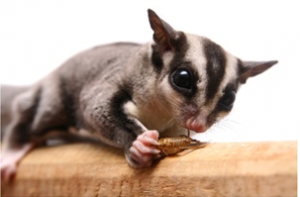 Q #1: What should I give them for breakfast? Meat or fruit…
Q #1: What should I give them for breakfast? Meat or fruit…
A #1: A proper diet should be 50% protein, 25% fruits, and 25% vegetables. There are many acceptable diets that you can follow, but it should adhere to that breakdown.
Q #2: What do I need to buy them as in toys, and what type? Bird or hamster? Or maybe anything specific you recommend I should buy?
A #2: Any toys that are safe for a toddler would be safe for sugar gliders. You can get bird or hamster toys, or even toys made for toddlers. Just stay away from cat toys because catnip is toxic to gliders. You should definitely get an exercise wheel that is safe for gliders (no center bar because their tails can get injured). The stealth wheel is a popular one.
Q #3: What age should I buy the sugar glider…baby or adult?
A #3: It may be easier to bond with younger gliders, but there are also many lovable adult gliders that are in need of homes. I highly recommend adopting a glider from a rescue organization if you can. If not, make sure to go through a reputable breeder.
Q #4: Do they bite? Does it hurt?
A #4: Sugar gliders can bite, and it does not feel good! It can puncture your skin if they bite hard enough.
Q #5: How many times should I feed them in a day?
A #5: You only need to put food out for them one time at night when they wake up. Make sure to remove any leftovers in the morning. You can also give them little treats throughout the day if they wake up.
Q #6: How do I handle their poo and urine?
A #6: Sugar gliders cannot be potty trained, so you will have to clean up after them. You will need to change out the removable tray in their cage pretty regularly. They can also have accidents when they are out playing, so you will just have to look out for any accidents to clean up.
Q #7: Can they actually fly?
A #7: Sugar gliders do not actually fly, but they glide. The patagium is the gliding membrane that attaches from the fifth finger to the first toe. This stretches out when they jump so they can glide through the air. In the wild, they can glide up to 150 feet from tree top to tree top as they search of food.
Q #8: Do sugar gliders get along with cats?
A #8: Sugar gliders do not get along with cats. Cats will go after gliders because they are prey animals that move quickly and attract the predator instinct in cats. Gliders will not feel safe around cats and can become stressed easily.
 Q: I am thinking about getting a sugar glider, but I have some questions. Do you need to get two gliders, because we went to a pet store and he said you need to get two, because apparently they could easily die of depression!
Q: I am thinking about getting a sugar glider, but I have some questions. Do you need to get two gliders, because we went to a pet store and he said you need to get two, because apparently they could easily die of depression!